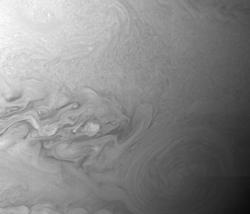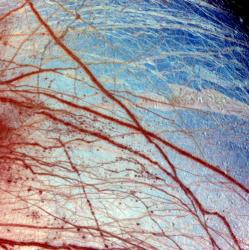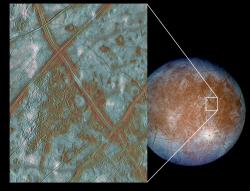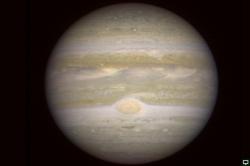 NASA’s New Horizons spacecraft got a big speed boost today, when it used Jupiter’s gravity to give it a slingshot towards its final destination of Pluto. It didn’t exactly skim the planet’s surface, but New Horizons got as close as 2.3 million kilometers (1.4 million miles) to Jupiter.
NASA’s New Horizons spacecraft got a big speed boost today, when it used Jupiter’s gravity to give it a slingshot towards its final destination of Pluto. It didn’t exactly skim the planet’s surface, but New Horizons got as close as 2.3 million kilometers (1.4 million miles) to Jupiter.
Continue reading “New Horizons Gets a Gravity Boost From Jupiter”
Scientists Lobbying to Search for Life on Europa
 Recently I reported on a proposal that spacecraft should return to Jupiter’s moon Europa to determine if it really has an ocean under its icy shell. Another group of scientists are lobbying for a return to Europa as well, as they feel it’s one of the most likely places to find other life in the Solar System.
Recently I reported on a proposal that spacecraft should return to Jupiter’s moon Europa to determine if it really has an ocean under its icy shell. Another group of scientists are lobbying for a return to Europa as well, as they feel it’s one of the most likely places to find other life in the Solar System.
Continue reading “Scientists Lobbying to Search for Life on Europa”
NASA’s Next Probe Should Visit Europa
 Arizona State University professor Ronald Greeley thinks that NASA’s next flagship mission to the outer planets should be sent to Europa, to help determine if the Jovian moon is a good place to search for life. Greeley presented his rationale at the annual meeting of the American Association for the Advancement of Science in San Francisco.
Arizona State University professor Ronald Greeley thinks that NASA’s next flagship mission to the outer planets should be sent to Europa, to help determine if the Jovian moon is a good place to search for life. Greeley presented his rationale at the annual meeting of the American Association for the Advancement of Science in San Francisco.
Continue reading “NASA’s Next Probe Should Visit Europa”
Looking at Jupiter, From Mars
 Guess who took this picture of Jupiter? Hubble? Keck? A well equipped amateur here on Earth? Nope, it was taken by the HiRISE camera on board the Mars Reconnaissance Orbiter. The picture was taken from orbit around Mars.
Guess who took this picture of Jupiter? Hubble? Keck? A well equipped amateur here on Earth? Nope, it was taken by the HiRISE camera on board the Mars Reconnaissance Orbiter. The picture was taken from orbit around Mars.
Continue reading “Looking at Jupiter, From Mars”
New Horizons Bearing Down on Jupiter
 Although New Horizons’ main target is Pluto and the Kuiper Belt, it’ll have plenty of opportunities to do some science along the way. Next up, Jupiter. The spacecraft is now just a few weeks away from its closest approach to the gas giant, where it’ll capture some images but also receive a much needed speed boost.
Although New Horizons’ main target is Pluto and the Kuiper Belt, it’ll have plenty of opportunities to do some science along the way. Next up, Jupiter. The spacecraft is now just a few weeks away from its closest approach to the gas giant, where it’ll capture some images but also receive a much needed speed boost.
Continue reading “New Horizons Bearing Down on Jupiter”
Red Spot Jr. is Getting Stronger
Jupiter’s newly formed Red Spot Jr. is increasing in strength, according to new observations from the Hubble Space Telescope. These latest measurements clock its windspeeds at 640 kph (400 mph); almost double the speeds recorded by the Voyager spacecraft when it observed one of the spot’s parent storms in 1979. The increased windspeed probably dredged up deeper material from the planet, changing its colour from white to red, similar to the Great Red Spot.
Continue reading “Red Spot Jr. is Getting Stronger”
New Horizons Sets its Sights on Jupiter
You might have seen better looking pictures of Jupiter before, but that’s not the point. What matters is that this photograph was taken by the Pluto-bound New Horizons spacecraft. It took the picture on September 4, 2006 when it was still 291 million km (181 million miles) away from Jupiter. Don’t worry, the pictures will get much better. It’ll make its closest approach on February 28, 2007, and see the giant planet with 125 times better resolution than this picture.
Continue reading “New Horizons Sets its Sights on Jupiter”
Jupiter’s Great Red Spots
Astronomers from UC Berkeley used the massive W.M. Keck Observatory in Hawaii to capture this infrared image of Jupiter and its two massive storms: the Great Red Spot and the smaller Oval BA. The image was taken on July 20, using the telescope’s adaptive optics system to sharpen the image. Scientists still aren’t sure why the spots have turned red, but they think it might be that they dredge darker material up from deeper in the planet’s atmosphere; when exposed to ultraviolet light from the Sun, this material turns red.
Continue reading “Jupiter’s Great Red Spots”
Red Spots Brush Past Each Other
Astronomers have been predicting the meetup for months; Jupiter’s Great Red Spot and its newly formed “Red Spot Jr.” were bound to have a close encounter. This high-resolution photo from the Gemini Observatory shows how they looked July 13, 2006. Although both are red in visible light, they look white because the image was captured in the near-infrared wavelength, which can reveal more details. Astronomers don’t think anything dramatic is going to happen as the storms slip past each other this time around.
Continue reading “Red Spots Brush Past Each Other”
Gas Giants Gobbled Up Most of Their Moons
Even though our Solar System’s gas giants vary widely in size and mass, they do have something in common. Each planet is roughly 10,000 times more massive than the combined mass of all their moons. During planetary formation, rocky moons grew out of the solid material surrounding each planet. As these moons grew larger, leftover gas slowed them down, and they fell into the planet to be consumed. The moons we see today were the last ones to form around their parent planets, after the gas had dissipated.
Continue reading “Gas Giants Gobbled Up Most of Their Moons”
